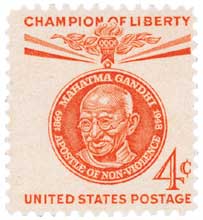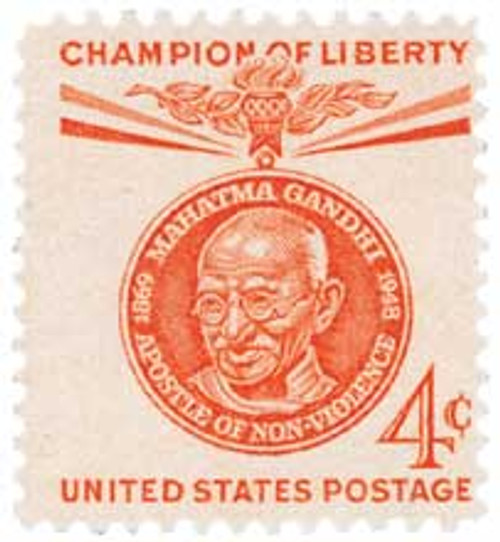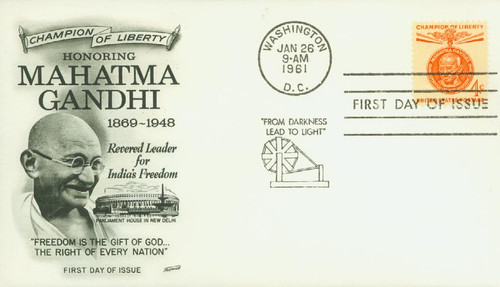
# 1174-75 - 1961 4c, 8c Mahatma Gandhi FDC
4¢ Mahatma Gandhi
Champions of Liberty Series
Mahatma Gandhi Assassinated
Mohandas Karamchand Gandhi was born on October 2, 1869, in Porbandar, India. The son of a government minister, Gandhi was a shy child, raised in the strict Jainism religion, which promoted non-violence, fasting, meditation, and vegetarianism. However, following his arranged marriage at the age of 13, he began to rebel – smoking, eating meat, and stealing.
Though he wanted to be a doctor, Gandhi followed his family’s wishes and studied to become a lawyer. He traveled to London in 1888 and found the transition to Western culture very difficult. During his three years there, he returned to a meatless diet and began studying world religions.
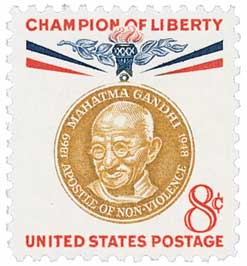
After returning to India in 1891, Gandhi struggled to make his living as a lawyer. He froze during his first case and ran out of the courtroom. Unable to find work after that, he got a one-year contract to work as a lawyer in South Africa. Arriving there in 1893, he was stunned by the discrimination and segregation Indian immigrants faced. Then, on June 7, 1893, a white man complained of his presence in a first-class railway car, even though he had a ticket. He refused to move to the back of the train and was forced off at the next station. That act of civil disobedience revealed to him his true calling – to fight discrimination, “root out the disease and suffer hardships in the process.”
The following year, Gandhi formed the Natal Indian Congress and spoke out against a law that prohibited Indians from voting. Though the law was passed, he brought the topic to the international stage. In the ensuing years, Gandhi established a successful law practice in South Africa and raised a 1,100-person volunteer ambulance corps during the Boer War. He believed that if Indians were to get full rights of citizenship, they should take on responsibilities like this as well.
Gandhi launched his first campaign of civil disobedience, which he called “Satyagraha” (“truth and firmness”) in 1906 to combat the limited rights of Indians. He led the peaceful protests for several years until he and hundreds of other were arrested and briefly imprisoned. He helped to negotiate their release, as well as well as the recognition of Hindu marriages and the end of poll taxes on Indians.
Returning to India in 1915, Gandhi dedicated his life to prayer, fasting, and meditation. It was at this time that he adopted the name “Mahatma,” which means “great soul.” Yet he couldn’t stay out of politics for long, and soon became a leader of the Indian home-rule movement, seeking independence from Great Britain. He encouraged his fellow countrymen to stop working for the British, attending their schools, paying their taxes, and purchasing their goods. He got a portable spinning wheel to make his own clothes, which became a symbol of Indian self-reliance.
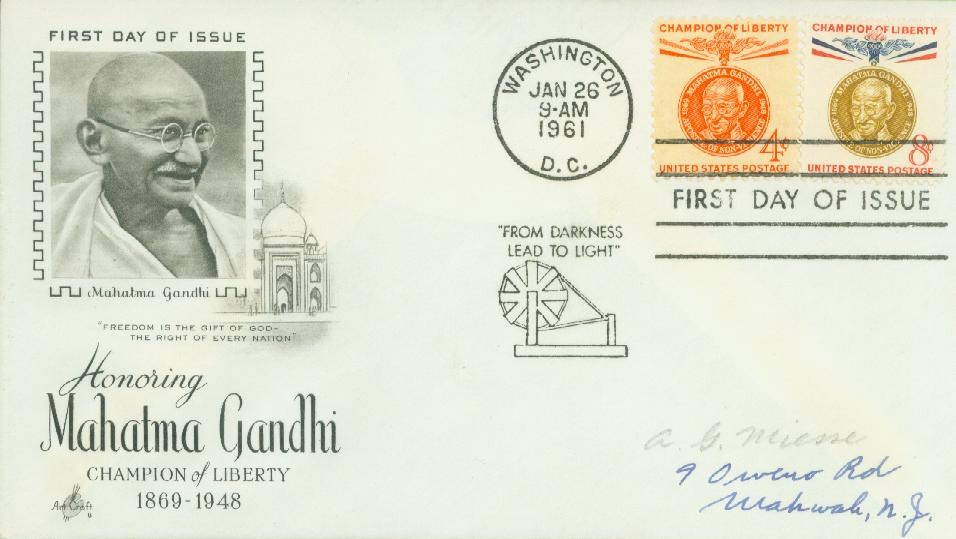
In 1930, Gandhi launched a Satyagraha campaign to protest the British Salt Acts, which prohibited Indians from collecting or selling salt, which was a large part of their diet. On March 12, he set out on a 24-day, 240-mile march to the Arabian Sea to collect salt in defiance of the law. This and similar protests (for which Gandhi was again arrested) led to some changes to the law. Gandhi became an international figure during the process and was named Time magazine’s “Man of the Year” in 1930.
Seventeen years later Gandhi helped negotiate India’s independence from Great Britain. However, his dream of a unified India wouldn’t happen, as it split into two independent states along religious lines – Hindu India and Muslim Pakistan. After independence was granted on August 15, 1947, he toured riotous areas to encourage peace, but some Hindus saw him as a traitor for sympathizing with Muslims.
And that ultimately led to his death. On January 30, 1948, Gandhi, who was weak from repeated hunger strikes, walked with his grandnieces to a prayer meeting. Along the way, a Hindu extremist that opposed his tolerance of Muslims, knelt before Gandhi and then shot him three times. His death sent shockwaves through the community and he was mourned nationwide, with over two million people joining his funeral procession. But his teachings of nonviolence lived on and inspired later civil rights leaders such as Martin Luther King, Jr. and Nelson Mandela.
4¢ Mahatma Gandhi
Champions of Liberty Series
Mahatma Gandhi Assassinated
Mohandas Karamchand Gandhi was born on October 2, 1869, in Porbandar, India. The son of a government minister, Gandhi was a shy child, raised in the strict Jainism religion, which promoted non-violence, fasting, meditation, and vegetarianism. However, following his arranged marriage at the age of 13, he began to rebel – smoking, eating meat, and stealing.
Though he wanted to be a doctor, Gandhi followed his family’s wishes and studied to become a lawyer. He traveled to London in 1888 and found the transition to Western culture very difficult. During his three years there, he returned to a meatless diet and began studying world religions.

After returning to India in 1891, Gandhi struggled to make his living as a lawyer. He froze during his first case and ran out of the courtroom. Unable to find work after that, he got a one-year contract to work as a lawyer in South Africa. Arriving there in 1893, he was stunned by the discrimination and segregation Indian immigrants faced. Then, on June 7, 1893, a white man complained of his presence in a first-class railway car, even though he had a ticket. He refused to move to the back of the train and was forced off at the next station. That act of civil disobedience revealed to him his true calling – to fight discrimination, “root out the disease and suffer hardships in the process.”
The following year, Gandhi formed the Natal Indian Congress and spoke out against a law that prohibited Indians from voting. Though the law was passed, he brought the topic to the international stage. In the ensuing years, Gandhi established a successful law practice in South Africa and raised a 1,100-person volunteer ambulance corps during the Boer War. He believed that if Indians were to get full rights of citizenship, they should take on responsibilities like this as well.
Gandhi launched his first campaign of civil disobedience, which he called “Satyagraha” (“truth and firmness”) in 1906 to combat the limited rights of Indians. He led the peaceful protests for several years until he and hundreds of other were arrested and briefly imprisoned. He helped to negotiate their release, as well as well as the recognition of Hindu marriages and the end of poll taxes on Indians.
Returning to India in 1915, Gandhi dedicated his life to prayer, fasting, and meditation. It was at this time that he adopted the name “Mahatma,” which means “great soul.” Yet he couldn’t stay out of politics for long, and soon became a leader of the Indian home-rule movement, seeking independence from Great Britain. He encouraged his fellow countrymen to stop working for the British, attending their schools, paying their taxes, and purchasing their goods. He got a portable spinning wheel to make his own clothes, which became a symbol of Indian self-reliance.

In 1930, Gandhi launched a Satyagraha campaign to protest the British Salt Acts, which prohibited Indians from collecting or selling salt, which was a large part of their diet. On March 12, he set out on a 24-day, 240-mile march to the Arabian Sea to collect salt in defiance of the law. This and similar protests (for which Gandhi was again arrested) led to some changes to the law. Gandhi became an international figure during the process and was named Time magazine’s “Man of the Year” in 1930.
Seventeen years later Gandhi helped negotiate India’s independence from Great Britain. However, his dream of a unified India wouldn’t happen, as it split into two independent states along religious lines – Hindu India and Muslim Pakistan. After independence was granted on August 15, 1947, he toured riotous areas to encourage peace, but some Hindus saw him as a traitor for sympathizing with Muslims.
And that ultimately led to his death. On January 30, 1948, Gandhi, who was weak from repeated hunger strikes, walked with his grandnieces to a prayer meeting. Along the way, a Hindu extremist that opposed his tolerance of Muslims, knelt before Gandhi and then shot him three times. His death sent shockwaves through the community and he was mourned nationwide, with over two million people joining his funeral procession. But his teachings of nonviolence lived on and inspired later civil rights leaders such as Martin Luther King, Jr. and Nelson Mandela.





